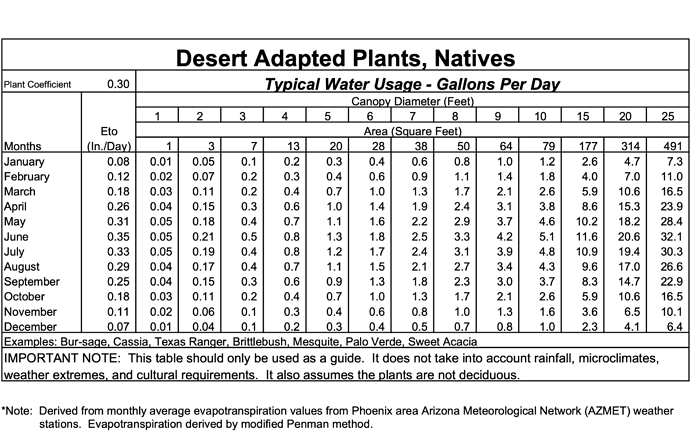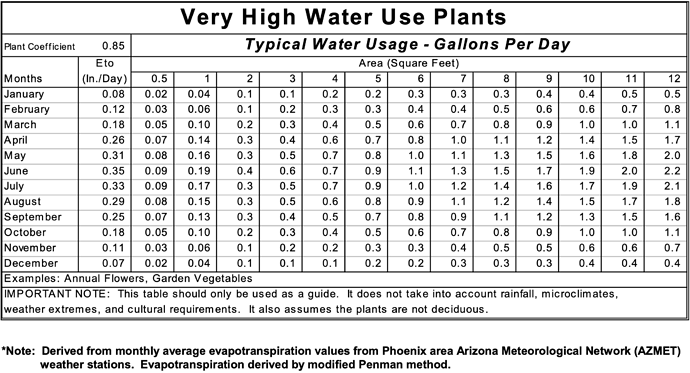We are doing final quality assessment and hope to release it within the next two weeks!
I am looking forward to it. I wonder how this will work if you know your area doesn’t fall into the default crop coefficient for a certain plant type. For example, I primarily have Turf Type Tall Fescue and Hybrid Bluegrass that appear to need less water than the average cool-season crop coefficient curve, especially because I only use slow-release fertilizers. Crop coefficients appear to be a spectrum and not a hard number.
Definitely looking forward to this. The missing link. Have been using your controllers since they first came out. Now on Gen 3.
My iOS app now has this dynamic crop coefficient option in the advanced menu for my zones. Sweet!
I did notice that my cool-weather grass here in northern CA is assigned a 97% coefficient, but the table I’ve been using shows 104% for April here in CA:
https://ucanr.edu/sites/UrbanHort/Water_Use_of_Turfgrass_and_Landscape_Plant_Materials/Turfgrass_Crop_Coefficients_Kc/
I realize that probably isn’t a huge difference, but kind of curious how Rachio is getting it’s data? Is it location-adjusted at all?
I noticed that annuals and perennials vegetation type have been merged into flower gardens.
How do the setting vary compared to the old annuals and perennials?
Do you have the dynamic crop coefficient charts for each plant type by month in my area?
I’m very hopeful that the dynamic crop coefficients will solve the problem I have had with my grad (St Augustine) not getting enough water in the heat of a Southeast Texas summer.
I have two beds that both contain both flowers and shrubs. My guess is that the flowers have a higher demand for more frequent watering, but would appreciate any suggestions as to which vegetation type to pick.
Are these documents available yet?
Would love more description about this new dynamic crop coefficient.
So the number that we set, is that the ceiling limit during the summer and the dynamic function will automatically tune down water frequency during winter months?
Or is the crop coefficient the floor for during winter months, but the dynamic function will increase watering frequency during summer months?
Or is the number we set is somewhere in the middle and the dynamic function will swing lower during winter months and higher during summer months?
Would love it if this gets explained in detail. It took me 3 years to finally get my schedule right for my orchard but I do manually adjust the crop coefficient depending on the season.
It seems to me that when I select dynamic crop coefficient, I can not adjust the number at all.
Are you seeing something different?
Perhaps @drew_thayer can help us better understand this new feature.
You’re absolutely right. For some reason mine wasn’t refreshing after I turned on the feature, so it let me move the slider but after leaving that screen and going back in, I cannot adjust it.
@drew_thayer I’m also curious how the adjustments are made. I really hope that it is using controller address to set a local, regional crop coefficient.
In looking at my alma mater, they have a number of studies from the Ag department on the subject. When I lock my dynamic crop coefficients for my warm season grass (just switched from cool season rye overseed now that it is warming up), it is currently locking at 60%, which falls into the “acceptable” range for quality of turf. The monthly breakdown chart is in regards to “fairway quality” turf, which isn’t what I’m necessarily looking for, so those numbers are significantly higher. 60% just seems to put it on the raged edge of acceptable and stressed. Hopefully it will bump up rather significantly as we push 100 degrees + here in Arizona.

This report was specific to Arizona desert landscapes, so I can’t speak for other regions…
When I set my summer grass crop coefficient to dynamic, it sets the value to 60%, and I can’t adjust it.
I’m in the Phoenix area, and for my turf 60% (the current dynamic coefficient default) is too low. For me to be able to use the dynamic crop coefficient setting, I would need to be able to adjust it up. A feature that allows one to add a percentage increase (or decrease) to the default dynamic value would be great!
Hopefully @drew_thayer will be able to respond.
Yea, mine is locked in at the same 60%. It might be “OK” for right this moment, but unless it starts ramping up pretty quickly, and pretty soon, I think there may be some issues. That is why I’m curious if they are using controller address and regional crop coefficients, or if it is the same across the country/world. If it is the same everywhere, I think it needs to be user defined “baseline” or a min/max that can be set based on region.
I have two controllers on my property, and I’m testing it on my smaller 6 zone controller for a back portion of my property to see how it responds.
I have manually adjusted my ETc by the month and that, for stone fruit trees, results in a dramatic increase of ETc. Like from .43 (April) to .86 (May). Right now dynamic ETc is at .46 for trees & that’s reasonable based on my favored document for California. If the controller makes a dramatic adjustment like that right away in May, I’ll be pleased. If it slowly ramps up to that, I’ll call that a bonus. I’m not seeing any slow increase though. Hopefully this will work out close to the way I manually adjust ETc.
What part of CA are you in? Northern CA here. Looks like I’m using the same document as you, and the dynamic is a touch lower than what is shown on the website. Would love to see if there are region-specific values, especially since April is 1.04 (!!) for cool-weather lawns.
@drew_thayer any updates on the links to the Kc curves, and can you confirm if this is a “global” curve, or regional?
I created some example crop coefficient curves based on AZMET values. My lawn example crop coefficient values are lower due to the footnotes from the AZMET snip, such as deep and infrequent watering, etc.
It would great if we could input a crop coefficient for each month of the year for each zone.
The dynamic crop coefficient may be too high/low for our particular location, plant type, etc. Allowing us to input our own values for each month would essentially give us our own personal dynamic crop coefficient.
Also, if I select dynamic crop coefficient, are those values based, in part, on location?
Hello all, we’re excited to see the interest in the Dynamic Crop Coefficient feature. We’ve written up an FAQ document that will address many of your questions, here: Dynamic Crop Coefficient FAQ
I’ll take some time here as well to address specific questions that have come up in this forum.
In a nutshell, this feature generates a new Kc value every month for all crops for every zone. When you turn the feature on, you’ll get that value for your zone and cannot edit the value. You can toggle the feature on and off as much as you like. The values are local to your climate, and will change every month.
@BigGeorge our hope is that this feature will help avoid the heat-stress problems you had in peak summer heat. If you think about a sinusoidal curve vs a flat line, it’s clear that the static Kc values we used to provide were really only accurate some time in Fall and Spring, and were likely leading to over-watering in the shoulder seasons and under-watering in summer for a lot of controllers (they did for my yard).
@twin1 @tmcgahey The Kc values for turfgrass are regional, varying by high-level climate types, for example a mediterranean climate on the west coast will have different values that steppe/ semi arid climates in the Rockies, southwestern deserts, eastern humid regions, etc. I’m sorry I can’t be any more specific at this time.
The Kc values for garden-type crops will vary slightly across even smaller climate micro-regions, roughly the size of western counties. This is because we fit expected growing season Kc values to the local growing season timing, and we can do this at a finer spatial resolution.
Data sources: we compiled the Kc curves for turfgrass from peer-reviewed research where available and other academic published documents (Master’s theses, Ag school department materials, etc) where needed. For other crop types, like vegetable and flower gardens, we’ve taken average seasonal values from the U.N. Food and Agricultural Organization (FAO) tables, which are extensive, and fit them to the local growing season (link to FAO tables is in the support document).
You have already provided some great concepts for improving this feature. To get this to market quickly we did not build an offset or an enter-your-own function, and those are good ideas. If you want to apply an offset this season, you can activate the feature on the first of the month, note the value, turn the feature off, and set the value with whatever offset you want. I realize that is a hack, and we really want to learn about the appetite for a feature like this so we can plan follow-up features.
You have also identified other changes made the user interface. @ECOBEARD we did indeed combine the ‘Annuals’ and ‘Perennials’ classes into a ‘Flower beds’ class. It turns out a lot of customers didn’t know what those really meant, and even for those that do, our garden aesthetics often combine them. The root zone depth and Kc parameters for this new class is close to the average of the old classes, erring a bit on the side of more frequent watering. We have also made under-the-hood changes to “vegetable garden”, which will water more frequently, and changed “xeriscape” to “desert-adapted”, which will water less frequently and is a great choice for native steppe and desert plants that are becoming popular landscape elements in the southwest. In addition, if you set up new zones, you will find a cleaner and more informative zone setup process that we hope will lead customers to get it right more often the first time.
It’s worth saying that some of you, @ECOBEARD etc, have a really good intuitive and data-driven handle on how to tune a Rachio controller to get optimal results on your yard. We designed this feature as a finely discretized, yet generalizable solution that will work for most yards, most of the time. It could be that what you’ve learned through research and trial and error works better for your yard, and if so, keep doing what you’re doing! And please let us know if when you find discrepancies; we’re committed to improving this feature and we want your feedback.










